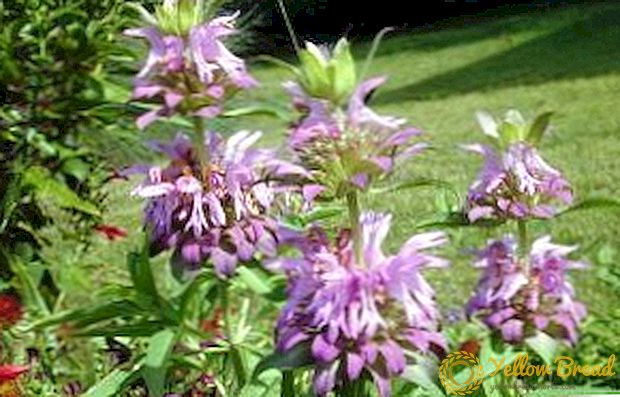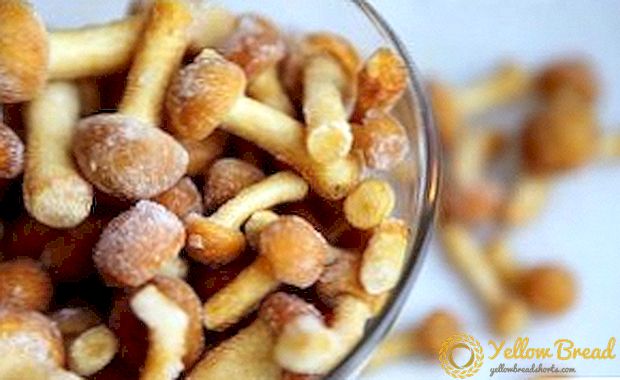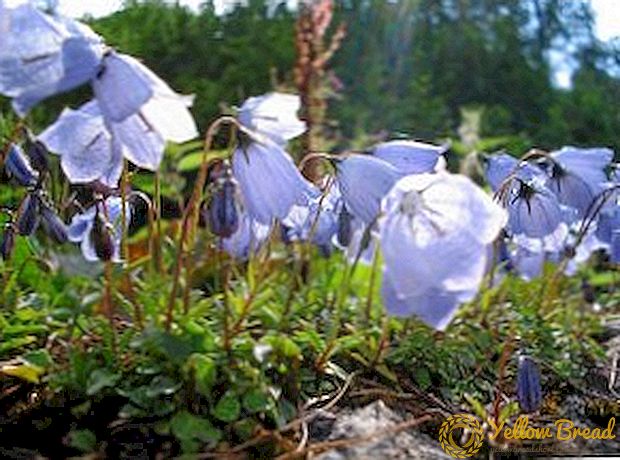 Among the most common pests of the garden can not distinguish gooseberry moth, which spoils a lot of harvest every year.
Among the most common pests of the garden can not distinguish gooseberry moth, which spoils a lot of harvest every year.
- What it looks like
- What harm
- Life cycle
- Risk group
- Signs of a fire moth
- Fighting gooseberry fodder
- Prevention
- Agrotechnical receptions
- Drug treatment
- Folk remedies
What kind of insect it is, what is its life cycle and how to deal with it - we will tell further.
What it looks like
Gooseberry moth is a small gray butterfly with a wingspan of up to 0.3 cm. The front pair has a gray color with brown stripes and white scales, and the back one is much lighter than the front and has a black edging.
The caterpillars of the pest are somewhat smaller and reach a length of about 1.2-1.4 cm. The caterpillar has a bright body, on which dark, blurred bands are clearly visible.
The anal and thoracic shields are brown, and the head is black. The brown pupa of the pest reaches 9 mm in length and has 8 curved spines on the cremaster.  She spends the whole winter in the topmost layer of soil, and with the arrival of spring and the appearance of buds, butterflies appear on the gooseberries and currants from the cocoons.
She spends the whole winter in the topmost layer of soil, and with the arrival of spring and the appearance of buds, butterflies appear on the gooseberries and currants from the cocoons.
What harm
Basically, the caterpillars eat the pulp and seeds of berries, as a result of which in a short period of time one caterpillar can kill 14 currant berries and 6 gooseberry berries.
Damaged and entangled with cobweb fruits become brown in color and dry out quickly. Thus, with the invasion of the moth, the entire crop is under threat.
Life cycle
Pupae of the pest spend the winter in the spider cocoons located in cracks or in the surface of the soil, not far from the currant bushes and gooseberries. The period of formation of buds on the plant is characterized by a massive flight of butterflies, which lasts almost a month.
At the end of the flowering period of the bushes the pest lays the eggs inside the flowers. Only one female can leave up to 200 eggs, distributing them two per flower. After 10 days, the caterpillars emerge from the clutch, which, in search of food, gnaw the buds and reach the ovary of the fruit.  If there are several caterpillars in one bud, then one of them will soon move to the nearest empty bud. Affected parts of the plant are covered with spider web.
If there are several caterpillars in one bud, then one of them will soon move to the nearest empty bud. Affected parts of the plant are covered with spider web.
The development and active feeding of the caterpillars lasts about 1 month, after which they will be fully prepared for pupation: they sink into the ground and are covered with a gray dense cocoon right at the base of the bushes. This period usually coincides with the ripening of berries affected by pest plants.
Only those instances to which the fire still reached, prematurely change color, and then rot or dry, and continuing to hang in the web. For the entire season, only one generation of gooseberry moth develops.
Risk group
As the name implies, gooseberry prefers gooseberries, but it feels good on currants or even raspberries.  In all these cases, they gnaw outside the ovary and unripe fruits, and also eat away the seeds (on the gooseberry). Other crops in the garden or in the garden firing pod is not terrible.
In all these cases, they gnaw outside the ovary and unripe fruits, and also eat away the seeds (on the gooseberry). Other crops in the garden or in the garden firing pod is not terrible.
Signs of a fire moth
It is easy to find this pest on a plant; it is enough just to inspect the bush, paying special attention to the berries on it. So, on the fruits you can find small holes, from which relatively thin cobwebs stretch to the neighboring ones.
It will take quite a bit of time, and such spoiled fruit will be much more. If you take a closer look at the lump of cobwebs on the gooseberry, then up to six berries can be inside it, some of which will be completely fresh, while others will be dried out and rotten. As for the currant, in a similar tangle, there are often up to 12 berries.  Having parted the discovered "nest" and having opened the largest and healthiest looking fruit, a surprise will be waiting for you inside it: along with the uneaten remains of seeds, there is usually a rather long (about 1 cm) bright green caterpillar of the little worm with a black head.
Having parted the discovered "nest" and having opened the largest and healthiest looking fruit, a surprise will be waiting for you inside it: along with the uneaten remains of seeds, there is usually a rather long (about 1 cm) bright green caterpillar of the little worm with a black head.
Over time, any of these eaten away fruits will only increase in size, and the caterpillars will gradually leave the berries and go down under the bush. Usually they do not crawl away and are located 30 cm from the stem of the plant.
Read also about such gooseberry pests:
Fighting gooseberry fodder
Of course, if you find a small moth on currant or gooseberry bushes, you will be interested in how you can effectively deal with it to save your crop.
There are several common methods, but it is best to perform timely prevention. 
Prevention
Preventive measures to combat the described pest mainly consist in timely mechanical harvesting of damaged berries and ovaries, on which traces of ophthalmic or moth bones are clearly visible.
This action will save the rest of the harvest from their persistent attention. All collected pests are usually destroyed with boiling water.
In addition, make it a rule to regularly inspect other plants adjacent to currants or gooseberries, since the same raspberry can be a source of fire.  And of course, you shouldn’t forget about the agrotechnology of growing plants, because when weakened, bushes are more susceptible to attacks of pests.
And of course, you shouldn’t forget about the agrotechnology of growing plants, because when weakened, bushes are more susceptible to attacks of pests.
The timely pruning of the shoots will also help, since the thickening of the landings only attracts pests. Bushes should be well lit and blown by air. And with the arrival of autumn, do not forget to remove all fallen leaves from under the bushes.
Agrotechnical receptions
In practice, it has been repeatedly proved that the most effective method of dealing with gooseberry pike moth is digging the soil around the bush. Despite the fact that this is quite a laborious process, hilling each bush with 10-15 cm of soil at its base will save the fruits from the appearance of butterflies. They simply cannot overcome such a layer of earth to get to the surface. However, one should not forget that it is better to take the soil from the row spacing and from a depth of at least 5 cm, where there are definitely no pupae. Ground under the bushes can spud compost or peat (layer up to 8-10 cm). After the end of the flowering period, such mulch should be removed.
An effective remedy is also the cultivation of the soil with a 12% solution of dust, and 10 days before opening the buds 50 g of dust powder is poured under the bush itself.
Drug treatment
No matter how hard you try to prevent the emergence of the gooseberry moth or get rid of it with the help of agricultural methods alone, the most effective control measures are based on the use of special preparations.
For example, Actellic, Etafos and Karbofos are well suited from chemical agents to combat ophilia. Spraying of these compounds is carried out immediately after flowering plants.
In addition, if this year the gooseberries and currants were massively affected by the fire moth, then next year the treatment with these means should be carried out before the flowering begins.
Folk remedies
After waiting for the gooseberry flowers to fully bloom (about 5 days from the beginning of flowering), the bushes are treated with an infusion of pharmacy chamomile, for which 100 g of dried flowers of the plant are pre-filled with 10 liters of hot water.
Alternatively, you can also use a mixture of pyrethrum powder and road dust (in a 1: 2 ratio) for dusting bushes. Sieve the dust thoroughly before mixing. After 5-6 days after the first pollination, the procedure should be repeated again.
If you do not know how to deal with ogniguka, since the pest has firmly settled on gooseberry and currant bushes, try again on the advice of I.V.Michurin "stick in them on the elder branch". To prepare a solution for the treatment of plants, 10 g of elderberry powder must be infused in 1 liter of water for 48 hours, then filtered.  Before direct processing, 150-200 ml of the concentrate should be diluted in 800-850 ml of water, and only then used. The processing procedure should be carried out in the evening, when butterflies are most active and massively fly over the bushes.
Before direct processing, 150-200 ml of the concentrate should be diluted in 800-850 ml of water, and only then used. The processing procedure should be carried out in the evening, when butterflies are most active and massively fly over the bushes.
In most cases, the recommendations described help to completely get rid of the pest, but if next year you again notice signs of vital activity of gooseberry ovipus on your plot, simply repeat all the above procedures again.






